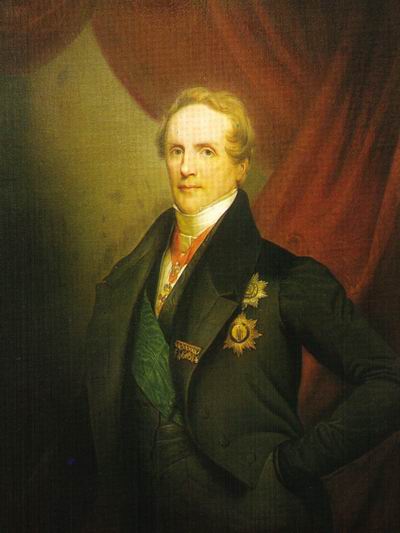- Frederick Augustus II of Saxony
Infobox Saxon Royalty
title = King of Saxony
name = Frederick Augustus II
full name = Frederick Augustus Albert Maria Clemens Joseph Vincenz Aloys Nepomuk Johann Baptista Nikolaus Raphael Peter Xavier Franz de Paula Venantius Felix

imgw = 180px
reign =June 6 1836 -August 9 1854
coronation =
predecessor =Anthony
successor =John
succession =King of Saxony
heir =
spouse =Marie Caroline of Austria
Maria Anna of Bavaria
issue =
royal house =House of Wettin
royal anthem =
father =Prince Maximilian of Saxony
mother =Princess Caroline of Parma
date of birth =birth date|1797|5|18|df=y
place of birth =Pillnitz
date of death =death date and age|1854|8|9|1797|5|18|df=y
place of death =Karrösten
place of burial=Katholische Hofkirche |Frederick Augustus II (full name: "Frederick Augustus Albert Maria Clemens Joseph Vincenz Aloys Nepomuk Johann Baptista Nikolaus Raphael Peter Xavier Franz de Paula Venantius Felix") ( _de. Friedrich August II.; b.
Dresden ,18 May ,1797 – d.Brennbüchel , inKarrösten , Tyrol,9 August ,1854 ) was King of Saxony and a member of theHouse of Wettin .He was the eldest son of
Maximilian, Prince of Saxony --younger son of the Elector Frederick Christian of Saxony-- by his first wife, Caroline of Bourbon, Princess of Parma.Life
Early Years
From his birth, it was clear that one day Frederick Augustus would become King of Saxony. His father was the only son of the Elector Frederick Christian of Saxony who left surviving male issue. When the King Frederick Augustus I died (1827) and Anton succeeded him as King, Frederick Augustus became second in line to the throne, preceded only by his father Maximilian.
He was an officer in the
Wars of Liberation . However, he had hardly interest in military affairs.Co-Regent to the Kingdom
The
July Revolution of 1830 inFrance marked the beginning of disturbances in Saxony that autumn. The people claimed a change in the constitution and demanded a young regent of the kingdom to share the government with the King Anton. On1 September the Prince Maximilian renounced his rights of succession in favor of his son Frederick Augustus, who was proclaimed Prince Co-Regent (de: "Prinz-Mitregenten") of Saxony. On2 February 1832 Frederick Augustus brought Free Autonomy to the cities. Also, by an edict of17 March of that year, the farmers were freed from the corvée and hereditary submission.King of Saxony
On
6 June 1836 the King Anton died and Frederick Augustus succeeded him as King. As an intelligent man, he was quickly popular with the people as he had been since the time of his regency. The new king solved political questions only from a pure sense of duty. Mostly he preferred to leave these things on the hands of his ministers.A standardized jurisdiction for Saxony created the
Criminal Code of 1836. During the Revolutionary disturbances of 1848 (March Revolution), he appointed liberal ministers in the government, lifted censorship, and remitted a liberal electoral law. Later his attitude changed. On28 April Frederick August II dissolved the Parliament. In 1849, Frederick Augustus was forced to flee to theKönigstein Fortress . The May Uprising was crushed by Saxon and Prussian troops and Frederick was able to return after only a few days.Accidental Death
During a journey in Tyrol, he had an accident in Brennbüchel in which he fell from in front of a horse that stepped on his head. On
8 August 1854 , he died in the Gasthof Neuner. He was buried on the16 August in theKatholische Hofkirche ofDresden . In his memory, the Dowager Queen Maria arranged to establish a King's chapel at the accident place, which was consecrated one year later.Marriages
In
Vienna on26 September 1819 (by proxy) and again inDresden on7 October 1819 (in person), Frederick Augustus married firstly with the Archduchess Maria Caroline of Austria (Maria Karoline Ferdinande Theresia Josephine Demetria), daughter of Emperor Francis I of Austria. They had no children.In
Dresden on24 April 1833 Frederick Augustus married secondly with the Princess Maria of Bavaria (Maria Anna Leopoldine Elisabeth Wilhelmine), daughter of the KingMaximilian I of Bavaria . Like his first marriage, this was childless.Without issue, after his death Frederick Augustus was succeeded by his younger brother, Johann.
Ancestors
Frederick Augustus II's ancestors in three generations
ahnentafel-compact5
style=font-size: 90%; line-height: 110%;
border=1
boxstyle=padding-top: 0; padding-bottom: 0;
boxstyle_1=background-color: #fcc;
boxstyle_2=background-color: #fb9;
boxstyle_3=background-color: #ffc;
boxstyle_4=background-color: #bfc;
boxstyle_5=background-color: #9fe;
1= 1. Frederick Augustus II of Saxony
2= 2.Prince Maximilian of Saxony
3= 3.Caroline of Bourbon-Parma
4= 4.Frederick Christian, Elector of Saxony
5= 5.Maria Antonia Walpurgis of Bavaria
6= 6.Ferdinand, Duke of Parma
7= 7. Marie Amalie of Austria
8= 8.Augustus III of Poland
9= 9.Maria Josepha of Austria
10= 10.Charles VII, Holy Roman Emperor
11= 11.Maria Amalia of Austria
12= 12.Philip, Duke of Parma
13= 13. Louise-Élisabeth of France
14= 14.Francis I, Holy Roman Emperor
15= 15.Maria Theresa of Austria s-ttl|title=King of Saxony
years=1836-1854
Wikimedia Foundation. 2010.
